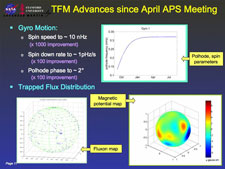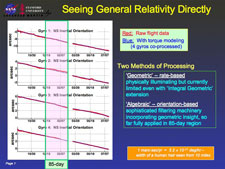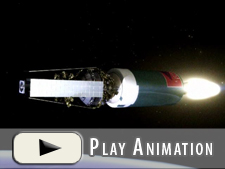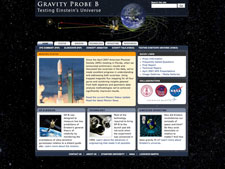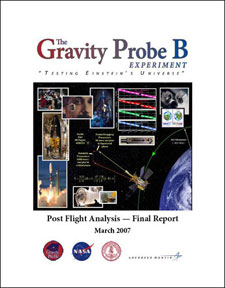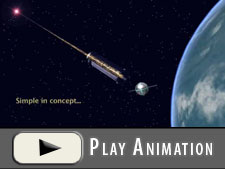MISSION UPDATE — DECEMBER 2007
PROGRAM STATUS
Over the past three months, GP-B has continued to make outstanding progress.
In our September 25, 2007 status update, we reported that the trapped flux mapping technique had resulted in a dramatic improvement in the determinations of the polhode phase and angle for each gyroscope throughout the entire 353-day experiment period. Applying these results to a central 85-day stretch of data, from December 12, 2004 through March 4, 2005, we obtained a robust and stable measurement of the frame-dragging effect with a reasonable (~30%) error level. We are in process of progressively extending the analysis to increasingly long time intervals in order to reach the full experiment accuracy, potentially to an error margin of less than 5%. Also important is the completion of the study of—and if necessary elimination of—any remaining systematic effects that may bias the results of the experiment.
Our progress and results were intensively reviewed by the GP-B Science Advisory Committee (SAC) at its 17th meeting on November 2, 2007. In its subsequent report, the SAC commented on "the truly extraordinary progress that has been made in data analysis since SAC-16 [March 23-24, 2007]" and unanimously concluded "that GP-B is on an accelerating path toward reaching good science results."
It is anticipated that approximately another six months until May 2008 will be needed to complete this full coverage and arrive at a definitive final result. We believe the results will be truly significant and will withstand scrutiny at the deepest scientific level. We agree with the SAC that: "This phase must include an adequate opportunity for the SAC to review the final result in some detail before publications are prepared and public announcements are made." To this end, we are planning on this review for the May 2008 time frame.
NEW GP-B WEB SITE COMING SOON...
For a number of months now, we have been the process of revising our whole Web site with the goal of updating and improving its look-and-feel, and more importantly, its ease of navigation. This work is nearing completion, and we expect to "go live" with the new site—here at this same URL—later this month. If you are a subscriber to our GP-B Update email list, we will send out a notification when the new site is up and running.
GP-B POST-FLIGHT ANALYSIS--FINAL REPORT TO NASA
Among the many projects we have been working on as the GP-B program approaches completion is our final Post Flight Analysis report to NASA. We began compiling some sections of this 616-page document while the GP-B experiment was still in progress. However, it has taken two more years to complete the final edits and prepare this report for public distribution.
Ultimately, this report will be assigned an official NASA document number and entered into the NASA Technical Reports server at the NASA Center for AeroSpace Information (CASI). In the meantime, we have posted the full report on our GP-B Web server in Adobe Acrobat PDF format for public viewing/downloading.
There are two versions of the report on the server:
- A highly-compressed, 12 MB screen viewable version. (Note: You can print pages from this version, but they will have very low-quality images.)
- A moderately-compressed, 29 MB printable version. (Note: Pages from this version will print acceptably on an ink jet or laser printer.)
LINKS TO OTHER GP-B TOPICS
- GP-B Frequently Asked Questions (FAQ)
- Track the satellite in the sky
- Build a paper model of the GP-B Spacecraft
- Our mailing list—receive GP-B status updates via email
- View a Flash video of Professor Everitt's 18 May 2006 lecture on GP-B
Note: Both audio-only and video versions of this lecture are also available on the Stanford on iTUNES U Web site. This Web page automatically launches the Apple iTunes program on both Macintosh and Windows computers, with a special Stanford on iTunes U "music store," containing free downloads of Stanford lectures, performances, and events. Francis Everitt's "Testing Einstein in Space" lecture is located in the Science & Technology—Engineering section. People with audio-only iPods can download the version under the Audio tab; people with 5th generation (video) iPods can download the version under the Video tab.
Previous Update | Index of Updates

